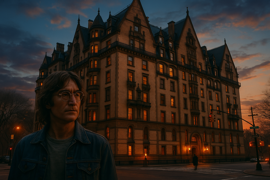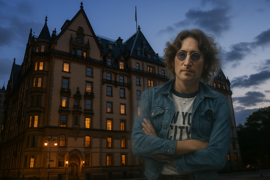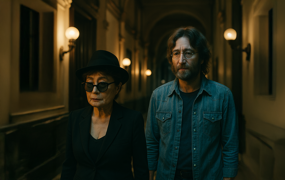John Lennon’s Spirit at Dakota
Reading Time: 14 min

About Story: John Lennon’s Spirit at Dakota is a Legend from united-states set in the Contemporary. This Poetic tale explores themes of Loss and is suitable for Adults. It offers Inspirational insights. A haunting journey through the Dakota, where Lennon’s spirit sparks timeless hope and poetic wonder. .
In the shadowed heart of New York City stands a monument to mystery and artistic legacy—the Dakota Building. Over the decades, its brick façade and storied halls have been the silent witnesses to whispers of the past, secrets murmured under dim streetlights, and an ethereal presence that has captivated the souls of passersby. Among these legends, one narrative stands out: the tale of John Lennon’s spirit, a gentle yet stirring force believed to wander these corridors. This is not a ghost story in the conventional sense, but rather a poetic recollection of a night when music and memory intertwined beneath the watchful eyes of New York’s urban skyline.
It all began on a crisp autumn evening when the golden hues of sunset melted into the cool blues of night. I found myself drawn to the Dakota, not merely by curiosity but by an inexplicable pull—almost as if the echoes of a distant melody beckoned me forward. There was an unmistakable energy in the air, a blend of nostalgia, sorrow, and hope, reminiscent of the messages John Lennon once wove through his words. It was as if his spirit, carrying the essence of peace and revolutionary love, had returned to grace the corridors of this very building. Walking up the worn stone steps, I felt a shiver that was not entirely due to the chill of the evening air. The Dakota, built in the early 20th century, exuded a timeless charm, its ornate details speaking of a bygone era when art and architecture blended seamlessly. Every brick and every arch seemed to carry a story—a silent testament to the lives that had once filled its rooms. I recalled reading about the tragic history that also touched this building, most notably the loss of a man whose influence had transcended music and touched the hearts of millions. John Lennon, whose life was cut tragically short, had left behind a legacy that was far more than just a collection of songs. His ideals of peace, love, and artistic freedom resonated deeply with those who dared to dream of a better world. Over the years, residents and visitors alike spoke of inexplicable occurrences—a soft hum in the hallway, a fleeting glimpse of a figure in the twilight, or the sudden feeling of a warm presence beside them. In hushed conversations, these accounts were shared as if they were sacred secrets, hints of the man who had given so much to humanity and was, in some inexplicable way, still present among us. The aura of the Dakota at night is profound. Shadows play upon the walls, and every footstep echoes with memories of the past. It was here that I met Mr. Alistair, an elderly gentleman who had lived in the building for over forty years. With a gentle smile and eyes that held countless stories, he recounted his own brush with the inexplicable. “There was a night,” he began, “when I heard a soft melody—like a lullaby—that filled the corridors. I followed it, and for a moment, I felt as though Lennon himself was there, guiding me.” His voice trembled with a mixture of wonder and wistfulness, evoking an image of a bygone era that refused to be forgotten. One particularly memorable evening, I found myself wandering the labyrinthine corridors of the Dakota, drawn by an inner compulsion I could neither explain nor resist. The building seemed to breathe with life, its old wood and timeworn wallpaper carrying secrets that spanned generations. I paused at a window overlooking the bustling street below, where the distant hum of New York melded with the rhythmic pulse of the city. In that moment, I felt the undeniable presence of another—a quiet, calming energy that seemed to emanate from the very walls themselves. As I turned a corner, the distant sound of a familiar tune reached my ears—a gentle melody that reminded me of Lennon’s signature ballads. The sound was soft, almost like a murmur, yet it stirred something deep within me. I followed the sound, my heart pounding in anticipation, until I reached a narrow staircase leading to a secluded part of the building. There, in the dim light, I saw a shadowy figure that vanished as quickly as it had appeared. But the music lingered—a soulful whisper that resonated with hope and melancholy. I paused, trying to steady my racing thoughts. Was it merely an echo of my imagination, or had I truly encountered something extraordinary? The building seemed to offer no clear answer, its silence deep and enigmatic. Still, the memory of that encounter remains etched in my mind, a gentle reminder that sometimes the past reaches out to us in the quietest of moments. In that ethereal encounter, I felt a profound connection—a meeting of souls across the boundaries of time and space. In the days that followed, the experience at the Dakota lingered like a half-remembered dream. I began to delve into the history of the building, reading every account and recollection available. Residents, long-time custodians of the building’s secrets, spoke of strange occurrences—of a warm light in the hallway, of music that drifted on the breeze, and of an inexplicable calm that settled over those who believed they had felt the presence of John Lennon’s spirit. The building itself seemed to sing its own quiet song—a hymn of memories and dreams. I spent hours in the quiet corners of its public spaces, letting my mind wander amidst the relics of the past. In one such moment of reflection, I found myself in the grand lobby, where the interplay of light and shadow created an almost surreal ambiance. The air was heavy with the scent of old wood and memories, and I could almost imagine the echoes of laughter, debates, and the soft strumming of a guitar. It was then that I noticed a peculiar detail: a faded poster on one of the walls, its edges curled with age, featuring an image of Lennon, his eyes full of unspoken promises of a better tomorrow. I stood before it for several minutes, feeling as though I were conversing with the man himself. His gentle gaze seemed to say, “Keep dreaming, keep loving.” In that silent communion, I understood that his spirit was not confined to memory but lived on in the hearts of those who believed in the transformative power of art and music. The true essence of the Dakota’s mystery revealed itself one stormy night—a night when the winds howled outside and the building’s ancient pipes seemed to sing with the voices of those long past. I had returned to the Dakota, compelled by an insatiable desire to reconnect with the experience that had so profoundly affected me. The rain pounded the windows, and the building took on an almost mystical quality, its corridors filled with an otherworldly luminescence. As I made my way through the silent hallways, I sensed an almost palpable shift in the atmosphere. It was as if the very air was charged with emotion, a silent dialogue between the present and the echoes of a vibrant past. I found myself drawn to a secluded corner of the building—a quiet nook that had once been a private sitting area. There, under the soft glow of a single lamp, I heard it again: the gentle strains of a familiar melody, delicate and soulful, resonating through the space. For several moments, time seemed to stand still. I closed my eyes and let the music wash over me, each note a reminder of Lennon’s enduring legacy. It wasn’t just the sound of a song; it was the very essence of his spirit, a testament to the power of art to transcend the boundaries of life and death. In that moment, I felt an overwhelming sense of peace, as though the burdens of the modern world had been lifted away by a gentle, unseen hand. It was a reminder that even in darkness, there is a spark of light—a spark that ignites hope and binds us together in our shared humanity. When I finally opened my eyes, the room was empty, yet the sense of presence remained, lingering like a soft, comforting whisper. I left that room with a renewed sense of purpose, carrying with me the profound realization that the Dakota was more than just a building—it was a living monument to the spirit of creativity, resilience, and love. In the weeks that followed my encounters, I found myself pondering the nature of memory, legacy, and the intangible bonds that connect us to those who have shaped our lives. John Lennon’s spirit, as experienced at the Dakota, was not something that could be captured by logic or confined to the pages of history. It was a living force—a testament to the transformative power of art, a symbol of hope in a world often fraught with chaos and despair. I began writing down my experiences, hoping to capture even a fraction of the wonder that had filled those nights. The Dakota, with its weathered bricks and timeless corridors, had become a sacred space—a place where the lines between the past and the present blurred into a harmonious symphony. I wrote of the soft glow of streetlights, the gentle murmur of voices echoing in the empty halls, and the almost tangible warmth of a presence that defied explanation. Yet, even as I documented my encounters, I was keenly aware of the ephemeral nature of such moments. The spirit of Lennon, like the notes of a cherished melody, could be fleeting—present one moment and gone the next, leaving behind only memories and the lingering hope that his ideals would continue to inspire. I realized that the true beauty of such experiences lay not in their permanence, but in the way they transformed us, urging us to look beyond the mundane and embrace the mysteries of life. The experience taught me that history is not merely a collection of dates and events, but a tapestry woven from the emotions, dreams, and passions of those who came before us. In the quiet moments at the Dakota, I had touched upon something timeless—a whisper of a bygone era that spoke of peace, love, and the unyielding spirit of creativity. It was a reminder that even in a world that often seems chaotic and indifferent, the echoes of a visionary soul can still be heard, guiding us toward a more compassionate and inspired future. As I walked away from the Dakota on that final morning, the early light of dawn painting the city in hues of gold and silver, I felt an overwhelming sense of gratitude. The encounter had been both surreal and deeply human—a convergence of history, art, and the ineffable power of memory. I carried with me not only the story of a ghostly presence but also the enduring legacy of a man who dared to dream and change the world. In the quiet solitude of that morning, I whispered a silent farewell to the spirit of Lennon, promising to honor his memory by nurturing the ideals he cherished. His presence at the Dakota was not a mere echo of the past, but a living reminder that art and love can transcend time and space, touching hearts in the most unexpected places. And as the city stirred awake, I knew that, in some quiet corner of New York, his spirit continued to inspire, a gentle beacon of hope amidst the ever-changing tides of life. Reflecting on that unforgettable journey, I realize that the story of John Lennon’s spirit at the Dakota is more than an account of ghostly encounters—it is a testament to the enduring power of art and the belief that even in silence, the voices of the past continue to speak to us. Each step along those aged corridors, every soft murmur of a remembered melody, served as a reminder that legends never truly die; they live on in the hearts and minds of those who dare to listen. In the end, the Dakota remains not only a building but a sanctuary of memories, a place where the boundaries between life and art blur into a continuous, soulful narrative. For those who visit, it offers a moment of introspection, a chance to remember that within every stone and every echo, there lies the power to inspire, to heal, and to transform the mundane into something truly extraordinary. Thus, the spirit of John Lennon—ever gentle, ever hopeful—continues to roam the halls of the Dakota, inviting us all to imagine a world where love and music are the true measures of a life well-lived. And for anyone who listens with an open heart, his whisper will forever remind us that the magic of art endures, guiding us on our journey through the labyrinth of time and memory. In sharing this tale, I hope to pass on a fragment of that enduring magic—a reminder that while the physical presence may fade, the essence of true creativity remains eternal. Whether you are a believer in the supernatural or simply a seeker of beauty in unexpected places, the story of John Lennon’s spirit at the Dakota serves as an invitation to pause, reflect, and perhaps, in the soft glow of a New York twilight, to hear the faint strains of a melody that carries a promise of hope, unity, and everlasting love. As I close this chapter of my own journey, I leave you with the thought that every moment holds the potential for wonder. The Dakota stands as a quiet guardian of countless stories, each brick and window a silent witness to the enduring spirit of those who dare to dream beyond the confines of the everyday. And somewhere amidst the echoes of that legendary melody, John Lennon’s spirit sings on—a soulful reminder that in the art of living, every note matters. The tale I share is not merely one of ghostly apparitions or urban legends; it is a human story of connection, memory, and the ceaseless pursuit of beauty. It reminds us that, no matter how far we wander or how lost we feel, there is always a spark—a gentle, guiding light—that calls us home. For in every whispered note, every fading echo, lies the heartbeat of a legacy that refuses to be forgotten. In New York, where dreams are as vast as the skyline and as enduring as the city’s history, the Dakota remains a monument to both the celebrated and the unseen. It is here, in the silent interplay of light and shadow, that the spirit of John Lennon lingers—an eternal muse for all who dare to dream of a better, more compassionate world. May this story inspire you to listen for the soft melodies that often go unnoticed, to cherish the whispers of history that shape our present, and to find beauty in the unexpected corners of life. For in the end, every heartbeat, every whispered song, is a testament to the enduring power of hope, art, and the boundless spirit of humanity. As you step away from this narrative, perhaps take a moment to imagine the quiet halls of the Dakota and the gentle presence that might still linger there. Let the memory of Lennon’s soulful tune serve as a gentle reminder that no matter where we go, the spirit of creativity and love endures, echoing softly in the spaces between our shared moments. And so, dear reader, may you carry this tale with you—a story woven from the threads of history, mystery, and the enduring human spirit. For as long as the Dakota stands and the city hums its eternal song, John Lennon’s spirit will remain, forever a part of the living, breathing heart of New York.The Echoes of History

A Chance Encounter in the Halls
The Melody of a Legend

A Night of Whispers
Reflections and Farewells


















